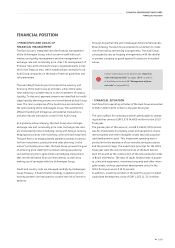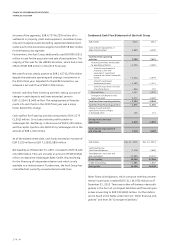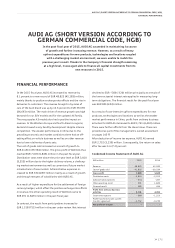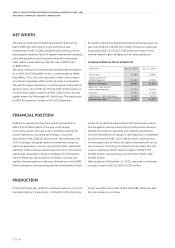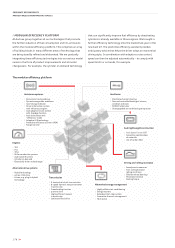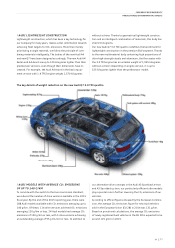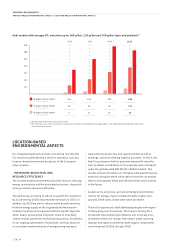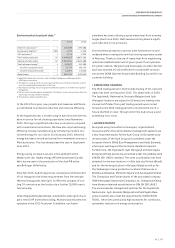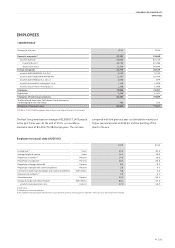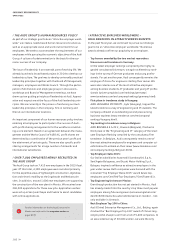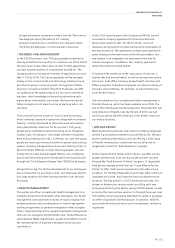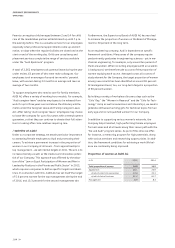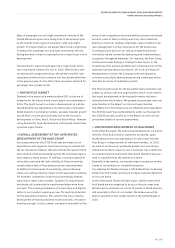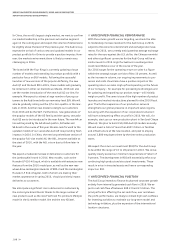Audi 2015 Annual Report Download - page 179
Download and view the complete annual report
Please find page 179 of the 2015 Audi annual report below. You can navigate through the pages in the report by either clicking on the pages listed below, or by using the keyword search tool below to find specific information within the annual report.
CORPORATE RESPONSIBILITY
LOCATION-BASED ENVIRONMENTAL ASPECTS
>> 179
Environmental structural data 1)
2015 2014
Direct CO2 emissions 2) t 220,306 199,584
Energy consumption 3) GWh 2,707 2,543
VOC emissions 4) t 1,774 1,959
Fresh water purchased m³ 4,044,587 3,867,569
Volume of waste water m³ 2,695,054 2,624,488
Total volume of waste 5) t 87,872 82,285
of which recyclable waste t 73,775 68,279
of which disposable waste t 14,097 14,006
Metal waste t 353,741 345,855
1) Ingolstadt, Neckarsulm, Brussels, Győr, Sant’Agata Bolognese and Bologna plants;
2015 figures provisional
2) This figure is made up of CO2 emissions generated by the use of fuel at the plant, and CO2
emissions produced by the operation of test rigs.
3) Total electrical energy, heat, fuel gases for production processes and externally supplied
refrigeration
4) VOC emissions (volatile organic compounds): This figure is made up of emissions from the
paint shops, test rigs and other facilities.
5) Including non-product-specific waste
In the 2015 fiscal year, new projects and measures additional-
ly contributed to emissions reduction and resource efficiency.
At the Ingolstadt site, a modern plug-in hybrid locomotive has
been in service for rail shunting operations since November
2015. It brings a significant reduction in emissions compared
with conventional locomotives. We have also improved energy
efficiency in body manufacturing by introducing modern con-
trol technology for our robots. Since January 2015, electrical
energy has been sourced exclusively from renewable sources in
Münchsmünster. This has already been the case in Ingolstadt
since 2012.
Energy-saving processes are also in the spotlight at the
Neckarsulm site. Highly energy-efficient Automated Guided
Vehicles are used in the production of the Audi R8 at the
new Böllinger Höfe facility.
Since fall 2015, Audi Hungaria has covered around 60 percent
of our Hungarian site’s heat requirements from the new geo-
thermal energy plant near Győr. It offers the prospect of cut-
ting CO2 emissions at the location by a further 19,800 metric
tons annually.
In Sant’Agata Bolognese (Italy), Automobili Lamborghini S.p.A.
put a new CCHP (combined cooling, heat and power) plant into
operation in the 2015 fiscal year. In addition, our Italian
subsidiary has been utilizing surplus waste heat from a nearby
biogas plant since 2015. Both measures bring about a signifi-
cant reduction in CO2 emissions.
Environmental protection concerns were furthermore accom-
modated when creating the new Audi driving experience center
in Neuburg. Thanks to the use of waste heat from neighboring
industrial establishments and of green power from hydroelec-
tric power stations, the power and heat supply is carbon-neutral.
Audi was awarded a Gold certificate for sustainable construc-
tion by the DGNB (German Sustainable Building Council) for its
customer building.
/EMISSIONS TRADING
The third trading period in the EU-wide trading of CO2 emission
rights has been running since 2013. This phase ends in 2020.
The Ingolstadt, Neckarsulm, Brussels (Belgium) and Győr
(Hungary) locations are subject to EU emissions trading rules.
Unused certificates from past trading periods were carried
forward to the third trading period to minimize the risk of a
future shortfall in cover, through which the Audi Group would
potentially incur costs.
/ACCREDITATION
Alongside using innovative technologies, organizational
measures within the environmental management systems are
a very important aspect for the Audi Group. All European auto-
motive plants of the Audi Group are accredited under the
European Union’s EMAS (Eco-Management and Audit Scheme),
which goes well beyond the minimum standards required.
Furthermore, the Ingolstadt, Győr (Hungary) and Sant’Agata
Bolognese (Italy) plants are accredited under the globally valid
DIN EN ISO 14001 standard. The same accreditation has been
obtained for the new location in in São José dos Pinhais (Brazil)
and for the motorcycle plant in Bologna (Italy) as well as for
the Volkswagen Group production locations that we use in
Bratislava (Slovakia), Martorell (Spain) and Aurangabad (India).
The Changchun and Foshan plants of the associated company
FAW-Volkswagen Automotive Company, Ltd., Changchun (China),
have likewise obtained accreditation to DIN EN ISO 14001.
The environmental management systems for the Ingolstadt,
Neckarsulm, Győr, Brussels (Belgium) and Sant’Agata Bolo-
gnese locations also meet the requirements of DIN EN ISO
50001, which sets particularly high standards for continuous,
systematic reductions in energy consumption.


